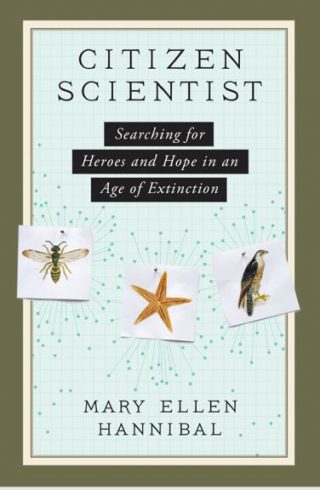Citizen Scientist: Searching for Heroes and Hope in an Age of Extinction
Posted in From the Library on August 7 2017, by Esther Jackson
Esther Jackson is the Public Services Librarian at NYBG’s LuEsther T. Mertz Library where she manages Reference and Circulation services and oversees the Plant Information Office. She spends much of her time assisting researchers, providing instruction related to library resources, and collaborating with NYBG staff on various projects related to Garden initiatives and events.
 Citizen Scientist: Searching for Heroes and Hope in an Age of Extinction is a book from popular science writer Mary Ellen Hannibal on the topic of citizen science.
Citizen Scientist: Searching for Heroes and Hope in an Age of Extinction is a book from popular science writer Mary Ellen Hannibal on the topic of citizen science.
Citizen science is scientific research conducted, in whole or in part, by amateur (or nonprofessional) scientists. Citizen science projects can include all manner of tasks and objectives, and many popular projects involve non-scientists making reports about organisms they have observed, such as bloom times, or phenology, of various plants. Still other projects involve virtual volunteering, such as transcribing specimen label data of herbarium sheets (or other specimens) that have been digitized and made available online.
In her book, Hannibal writes about her experiences working as a citizen scientist on various projects, mostly involving the observation of animals under the direction of trained professional scientists. It is clear that Hannibal enjoys the English language, and this memoir of sorts is littered with references to literary works, historical figures, and poetry-like observations of the natural world. It’s not really a science book at all, although Hannibal does write in praise of the natural world.
At NYBG, there are several citizen science projects in which readers might be interested in participating. Current projects include the New York City EcoFlora project, the Thain Family Forest Phenology Project, and the New York Botanical Garden Herbarium Stewards Club. An upcoming project through the NYBG LuEsther T. Mertz Library will involve working with volunteers to assist in transcribing the digitized correspondence of John Torrey, another citizen science initiative of sorts.
Returning to the review at hand, and setting aside more personal stylistic quibbles, my one main criticism of Citizen Scientist is the fact that Hannibal characterizes famed North American botanist Alice Eastwood as a “citizen scientist.” Starting in 1891, Eastwood began to build the botanical collections at the California Academy of Sciences, eventually serving as the Head of the Department of Botany from 1894 until 1949. She published over 310 scientific articles. Eastwood may not have had a college degree, but neither was she an amateur worker. Hannibal has clearly framed Eastwood as a citizen scientist in order to highlight the importance of the work of amateurs, but in doing so has only succeeded in minimizing the work of a prolific and dedicated professional female botanist. Hannibal is clearly quite taken with Eastwood and her accomplishments, making it all the more baffling that she would downplay Eastwood’s professionalism in support of amateur workers. Hannibal would likely argue that to frame Eastwood as a citizen scientist only elevates citizen scientists, but there is a vast difference between historical amateur botanists (many of them women) and someone who was the head of a botany department for over 50 years. This element of the book was a hard, hard miss.
Citizen Scientist is a snapshot in time of Hannibal’s experiences as a citizen scientist. Readers who enjoy memoirs with elements of popular science writing will enjoy this book.

